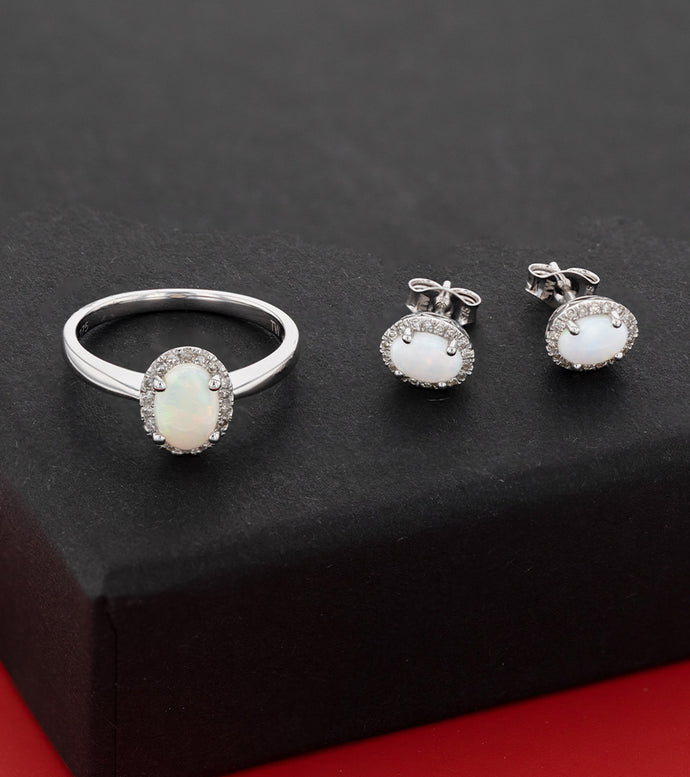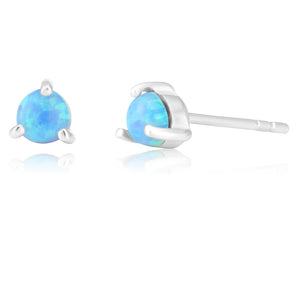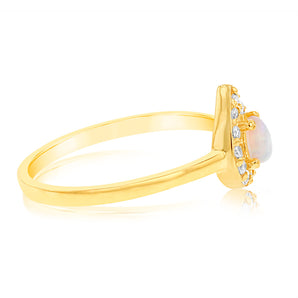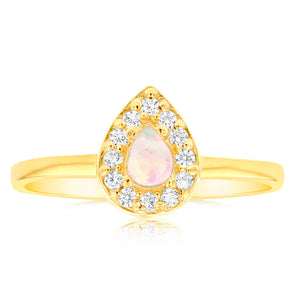October Birthstone
With its striking iridescent surface and its intriguing history and lore, the October birthstone is arguably one of the most unique gemstones out of them all. Appearing in many colours, the opal is often regarded as one of the world's most precious gemstones due to its unmistakable beauty and rarity.
While shoppers are often very picky about other gemstones and their flaws or lack thereof, opals are the one gemstone that is appreciated for their unique markings and natural imperfections. It is because of this that this enchanting stone is left in its natural state when produced into opal jewellery.
From its unconventional origins to its fascinating mythology, read on as we unpack all there is to know about the October birthstone.
OVERVIEW OF THE OCTOBER BIRTHSTONE:
- Meanings & physical components of October birthstone
- The history of opals
- Where are opals found?
- Our favourite opal jewellery

MEANINGS AND PHYSICAL COMPONENTS OF OPALS
Not surprisingly, a stone as eclectic as the opal has garnered a myriad of meanings over time. Some of which are good, some that are bad and some that are just plain quirky. One label that unfortunately stuck with the opal for some time is that they are a symbol of bad luck. This belief stems from Scottish writer Sir Walter Scott's bestselling novel, Annie of Geurestein. Written in 1829, the book centres around a woman who is accused of being a demon and is killed after a drop of holy water falls onto her opal and destroys its colour.
The public seemingly took this information and ran with it, believing the author was using the book to warn readers of the bad luck that an opal can potentially bring. This caused people to stop buying the precious stones and within 6 months of the novel's release, opal sales had plummeted and prices were at an all-time low. Thankfully, this superstition didn't last and the stone has since become a symbol of many positive meanings.
A symbol of fidelity and assurance, it was once believed that by wearing opal you would help amplify your character traits. The stone is also said to give your confidence a boost while also enhancing your self-worth and self-esteem by helping you understand your full potential. Some also believe that the stone can help stimulate originality, creativity while also encouraging an interest in the arts.
Seen as a karmic stone that emits positive energy and teaches you that what you put out comes back to you, the opal is absorbent and reflective which is believed to represent thoughts and feelings. Representative of love, passion, desire, justice and harmony, in ancient times the stone would often be worn for protection.
Unlike a majority of gemstones which are formed when the inner-earth is exposed to high temperatures and pressure, opals are formed when it rains. Composed of silicon dioxide and water, opals are created when water runs down through the earth and picks up silica from sandstone on the way. This silica-rich solution then makes its way into the earth's cracks and crevices which form due to natural faults or decomposing fossils. Soon after, the water evaporates, leaving behind a silica deposit.
This cycle is repeated over long periods until eventually opal is formed. Their vibrant colours are produced when white lights enter the top of the opal during its composition. As they enter, they refract and bounce around inside the stone through all the microscopic spheres and gaps. When the light passes through, it splits like a prism, causing all colours of the spectrum to appear. The light eventually bounces out the top of the stone at which point the opal's stunning iridescent colour appears.

THE HISTORY OF OPALS
Since around 4000 BC, opal stones have been lauded by many cultures and civilizations. Admirers have compared opals to other natural wonders of the world including volcanoes, fireworks and galaxies. In Aboriginal Dreamtime stories, the stones are said to get their vibrant flashing colours when a rainbow reaches the earth.
In Arabia, locals believed that opals fell from the heavens following lightning and thunderstorms. Roman politician and Cleopatra's lover, Marc Antony was believed to be infatuated by the iridescent stone. So much so that he is said to have banished Roman Senator Nonius after he refused to sell him his almond-sized opal stone. Legend has it that the Roman Emperor offered to trade one-third of his vast kingdom for a single opal. Now, that is dedication.
During the Middle Ages, opals were referred to as the eye stone' due to the belief that wearing the stone would promote good eyesight. Some even thought that the opal's effect on sight would render the wearer invisible. Blonde women would even fashion opals into necklaces to prevent their hair from losing its colour and lustre. Opal necklaces are truly one of a kind.
Opals were also deeply admired in France at the time, with Napoleon having the stone set into the French Crown Jewels and gifting his love, Empress Josephine, a brilliant red opal. While across the channel over in England, Queen Victoria who had a vast collection of opals was given a fine opal ring by her aunt, Princess Mary, Duchess of Gloucestershire.
During the late 18th centuries and early 19th centuries, the popularity of opals began to wane. This would all change when German geologist Johannes Menge stumbled across opal deposits near Angaston, South Australia in 1849. Further deposits would be found in New South Wales and Queensland, which would bring miners to areas like White Cliffs and Lightning Ridge in New South Wales as well as Opalton in Queensland.
When Australian opals began circulating in the world trade market during the 1890s, Hungarian miners began spreading rumours that the opals were not genuine. Many believe this was because they hadn't seen stones with so much vibrancy before. Unable to compete with the high-quality stones being produced in Australia, a majority of the opal mines in Europe ceased operations soon after.

WHERE ARE OPALS FOUND?
Given the natural brilliance of the stones, Australia accounts for around 95-97% of the world's opal production. It is a stone that has practically become synonymous with our nation. The South Australian town of Coober Pedy is responsible for a large portion of the countries' opals, with over 70 opal fields it is the largest opal mine in the world. Other major opal mines in Australia are located in Lightning Ridge which is responsible for the extremely rare black opal, White Cliffs, Boulder Opal Country in Queensland as well as Quilipe which is also in Queensland.
The largest opal stone ever encountered is the Olympic Australis. Discovered in 1956 at the Eight Mile' an opal field near Coober Pedy, the stone weighs around 17,000 carats and was found at a depth of 9.1 metres. The stone was said to be valued at around $2,500,000 back in 1997. Named after the Olympic Games which were to be held in Melbourne the year of the stone's discovery, since 1997 the stone has been on display in Sydney at offices of Altmann & Cherny Ltd, a company which produces and sells opals.

OUR FAVOURITE OPAL JEWELLERY
Nothing pops in your personal collection quite like sky blue turquoise jewellery. Check out some of our favourite turquoise earrings and more below.




































